 | –≠–ª–µ–∫—Ç—Ä–æ–Ω–Ω—ã–π –∫–æ–º–ø–æ–Ω–µ–Ω—Ç: X5001V8 | –°–∫–∞—á–∞—Ç—å:  PDF PDF  ZIP ZIP |

1
Æ
FN8125.0
CAUTION: These devices are sensitive to electrostatic discharge; follow proper IC Handling Procedures.
1-888-INTERSIL or 1-888-352-6832
|
Intersil (and design) is a registered trademark of Intersil Americas Inc.
Copyright Intersil Americas Inc. 2005. All Rights Reserved
All other trademarks mentioned are the property of their respective owners.
X5001
CPU Supervisor
FEATURES
∑ 200ms power-on reset delay
∑ Low V
CC
detection and reset assertion
--Five standard reset threshold voltages
--Adjust low V
CC
reset threshold voltage using
special programming sequence
--Reset signal valid to V
CC
= 1V
∑ Selectable nonvolatile watchdog timer
--0.2, 0.6, 1.4 seconds
--Off selection
--Select settings through software
∑ Long battery life with low power consumption
--<50µA max standby current, watchdog on
--<1µA max standby current, watchdog off
∑ 2.7V to 5.5V operation
∑ SPI mode 0 interface
∑ Built-in inadvertent write protection
--Power-up/power-down protection circuitry
--Watchdog change latch
∑ High reliability
∑ Available packages
--8-lead TSSOP
--8-lead SOIC
--8 pin PDIP
DESCRIPTION
This device combines three popular functions, Power-
on Reset, Watchdog Timer, and Supply Voltage
Supervision in one package. This combination lowers
system cost, reduces board space requirements, and
increases reliability.
The watchdog timer provides an independent protec-
tion mechanism for microcontrollers. During a system
failure, the device will respond with a RESET signal
after a selectable time out interval. The user selects the
interval from three preset values. Once selected, the
interval does not change, even after cycling the power.
The user's system is protected from low voltage condi-
tions by the device's low V
CC
detection circuitry. When
V
CC
falls below the minimum V
CC
trip point, the system
is reset. RESET is asserted until V
CC
returns to proper
operating levels and stabilizes. Five industry standard
V
TRIP
thresholds are available, however, Intersil's
unique circuits allow the threshold to be reprogrammed
to meet custom requirements or to fine-tune the thresh-
old for applications requiring higher precision.
The device utilizes Intersil's proprietary Direct Write
TM
cell for the watchdog timer control bits and the V
TRIP
storage element, providing a minimum endurance of
100,000 write cycles and a minimum data retention of
100 years.
BLOCK DIAGRAM
Watchdog
Timer
Data
Register
Command
Decode &
Control
Logic
SI
SO
SCK
CS/WDI
V
CC
Watchdog
Transition
Detector
Reset &
Watchdog
Timebase
Power-on/
Generation
V
TRIP
+
-
RESET
REset
Low Voltage
Data Sheet
April 6, 2005
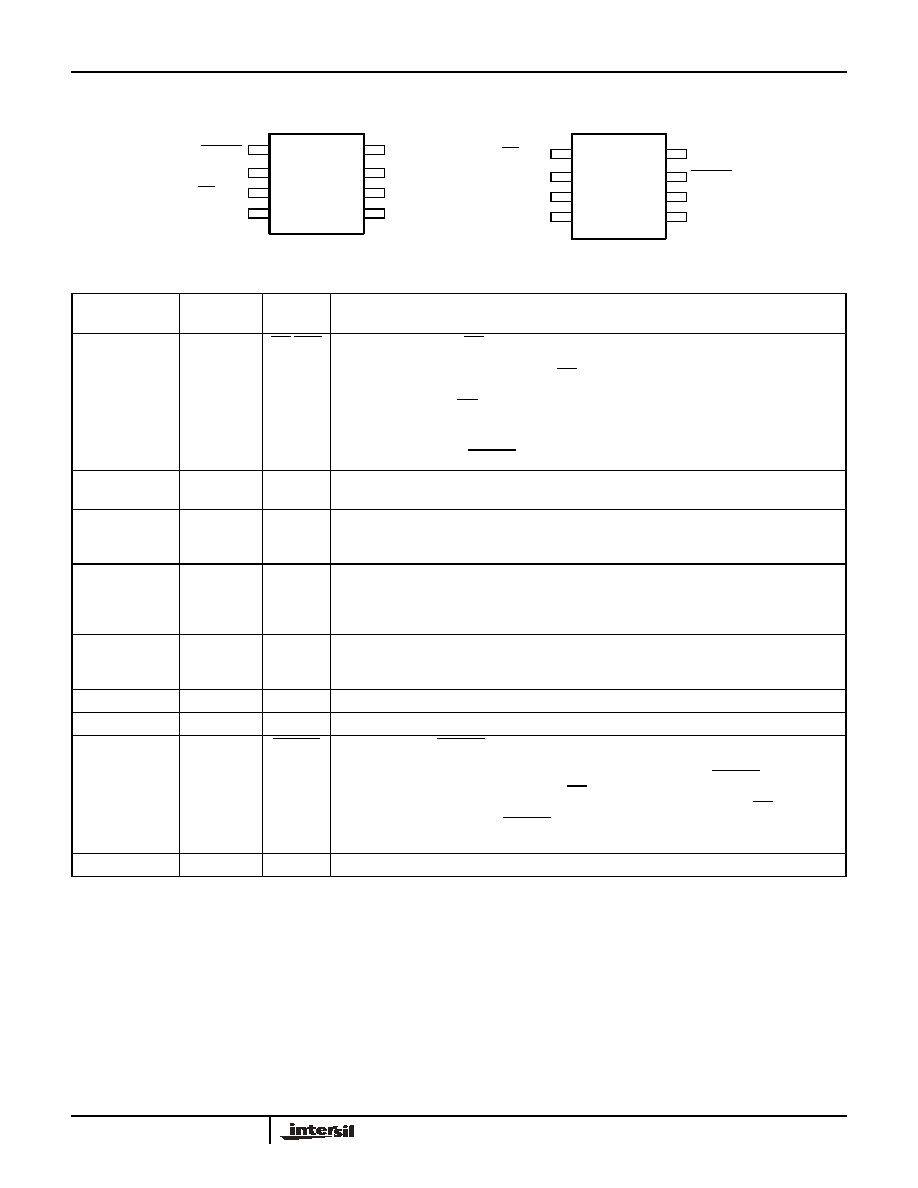
2
FN8125.0
April 6, 2005
PIN CONFIGURATION
PIN DESCRIPTION
Pin
(SOIC/PDIP)
Pin
TSSOP
Name
Function
1
1
CS/WDI
Chip Select Input.
CS HIGH, deselects the device and the SO output pin is at
a high impedance state. Unless a nonvolatile write cycle is underway, the device
will be in the standby power mode. CS LOW enables the device, placing it in the
active power mode. Prior to the start of any operation after power-up, a HIGH to
LOW transition on CS is required.
Watchdog Input. A HIGH to LOW transition on the WDI pin restarts the Watch-
dog timer. The absence of a HIGH to LOW transition within the watchdog time
out period results in RESET/RESET going active.
2
2
SO
Serial Output. SO is a push/pull serial data output pin. A read cycle shifts data
out on this pin. The falling edge of the serial clock (SCK) clocks the data out.
5
8
SI
Serial Input. SI is a serial data input pin. Input all opcodes, byte addresses, and
memory data on this pin. The rising edge of the serial clock (SCK) latches the
input data. Send all opcodes (Table 1), addresses and data MSB first.
6
9
SCK
Serial Clock. The Serial Clock controls the serial bus timing for data input and
output. The rising edge of SCK latches in the opcode, address, or watchdog bits
present on the SI pin. The falling edge of SCK changes the data output on the
SO pin.
3
6
V
PE
V
TRIP
Program Enable. When V
PE
is LOW, the V
TRIP
point is fixed at the last
valid programmed level. To readjust the V
TRIP
level, requires that the V
PE
pin be
pulled to a high voltage (15-18V).
4
7
V
SS
Ground
8
14
V
CC
Supply Voltage
7
13
RESET
Reset Output.
RESET is an active LOW, open drain output which goes active
whenever V
CC
falls below the minimum V
CC
sense level. It will remain active un-
til V
CC
rises above the minimum V
CC
sense level for 200ms. RESET goes active
if the watchdog timer is enabled and CS/WDI remains either HIGH or LOW long-
er than the selectable watchdog time out period. A falling edge of CS/WDI will
reset the watchdog timer. RESET goes active on power-up at 1V and remains
active for 200ms after the power supply stabilizes.
3-5,10-12
NC
No internal connections
8-Lead SOIC/PDIP
X5001
CS/WDI
SO
1
2
3
4
RESET
8
7
6
5
V
CC
V
SS
SCK
SI
SCK
SI
V
SS
V
CC
CS/WDI
SO
1
2
3
4
8
7
6
5
8-Lead TSSOP
RESET
V
PE
V
PE
X5001
X5001

3
FN8125.0
April 6, 2005
PRINCIPLES OF OPERATION
Power-on Reset
Application of power to the X5001 activates a power-
on reset circuit. This circuit goes active at 1V and pulls
the RESET/RESET pin active. This signal prevents
the system microprocessor from starting to operate
with insufficient voltage or prior to stabilization of the
oscillator. When V
CC
exceeds the device V
TRIP
value
for 200ms (nominal) the circuit releases RESET,
allowing the processor to begin executing code.
Low Voltage Monitoring
During operation, the X5001 monitors the V
CC
level
and asserts RESET if supply voltage falls below a pre-
set minimum V
TRIP
. The RESET signal prevents the
microprocessor from operating in a power fail or
brownout condition. The RESET signal remains active
until the voltage drops below 1V. It also remains active
until Vcc returns and exceeds V
TRIP
for 200ms.
Watchdog Timer
The watchdog timer circuit monitors the microprocessor
activity by monitoring the WDI input. The microproces-
sor must toggle the CS/WDI pin periodically to prevent
a RESET signal. The CS/WDI pin must be toggled
from HIGH to LOW prior to the expiration of the watch-
dog time out period. The state of two nonvolatile control
bits in the watchdog register determine the watchdog
timer period.
Vcc Threshold Reset Procedure
The X5001 is shipped with a standard V
CC
threshold
(V
TRIP
) voltage. This value will not change over normal
operating and storage conditions. However, in applica-
tions where the standard V
TRIP
is not exactly right, or if
higher precision is needed in the V
TRIP
value, the
X5001 threshold may be adjusted. The procedure is
described below, and requires the application of a high
voltage control signal.
Setting the V
TRIP
Voltage
This procedure is used to set the V
TRIP
to a higher
voltage value. For example, if the current V
TRIP
is 4.4V
and the new V
TRIP
is 4.6V, this procedure will directly
make the change. If the new setting is to be lower than
the current setting, then it is necessary to reset the trip
point before setting the new value.
To set the new V
TRIP
voltage, apply the desired V
TRIP
threshold voltage to the V
CC
pin and tie the W
PE
pin to
the programming voltage V
P
. Then a V
TRIP
programming
command sequence is sent to the device over the SPI
interface. This V
TRIP
programming sequence consists of
pulling CS LOW, then clocking in data 03h, 00h and 01h.
This is followed by bringing CS HIGH then LOW and
clocking in data 02h, 00h, and 01h (in order) and bringing
CS HIGH. This initiates the V
TRIP
programming
sequence. V
P
is brought LOW to end the operation.
Resetting the V
TRIP
Voltage
This procedure is used to set the V
TRIP
to a "native"
voltage level. For example, if the current V
TRIP
is 4.4V
and the new V
TRIP
must be 4.0V, then the V
TRIP
must
be reset. When V
TRIP
is reset, the new V
TRIP
is some-
thing less than 1.7V. This procedure must be used to
set the voltage to a lower value.
To reset the V
TRIP
voltage, apply greater than 3V to
the V
CC
pin and tie the W
PE
pin to the programming
voltage V
P
. Then a V
TRIP
command sequence is sent
to the device over the SPI interface. This V
TRIP
pro-
gramming sequence consists of pulling CS LOW, then
clocking in data 03h, 00h and 01h. This is followed by
bringing CS HIGH then LOW and clocking in data 02h,
00h, and 03h (in order) and bringing CS HIGH. This
initiates the V
TRIP
programming sequence. V
P
is
brought LOW to end the operation.
X5001
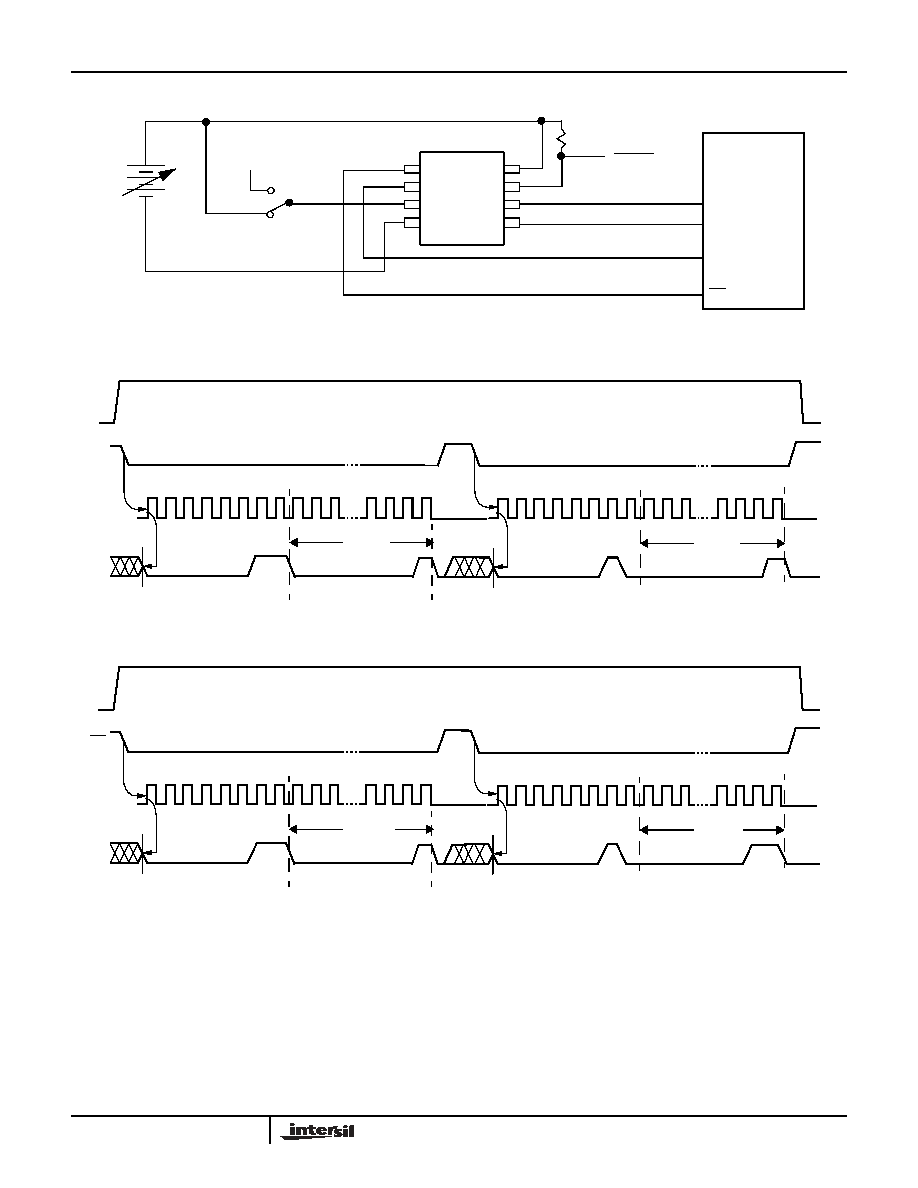
4
FN8125.0
April 6, 2005
Figure 1. Sample V
TRIP
Reset Circuit
Figure 2. Set V
TRIP
Level Sequence (V
CC
= desired V
TRIP
value)
Figure 3. Reset V
TRIP
Level Sequence (V
CC
> 3V)
1
2
3
4
8
7
6
5
X5001
V
TRIP
Adj.
V
P
RESET
4.7K
SI
SO
CS
SCK
µC
Adjust
Run
0 1 2 3 4 5 6 7 8 9 10
SCK
SI
CS
20 21 22 23
16 Bits
0001h
03h
0 1 2 3 4 5 6 7 8 9 10
20 21 22 23
16 Bits
0001h
02h
V
PE
V
PE
= 15-18V
0 1 2 3 4 5 6 7 8 9 10
SCK
SI
CS
20 21 22 23
16 Bits
0001h
03h
0 1 2 3 4 5 6 7 8 9 10
20 21 22 23
16 BITS
0003h
02h
V
PE
V
PE
= 15-18V
16 Bits
X5001
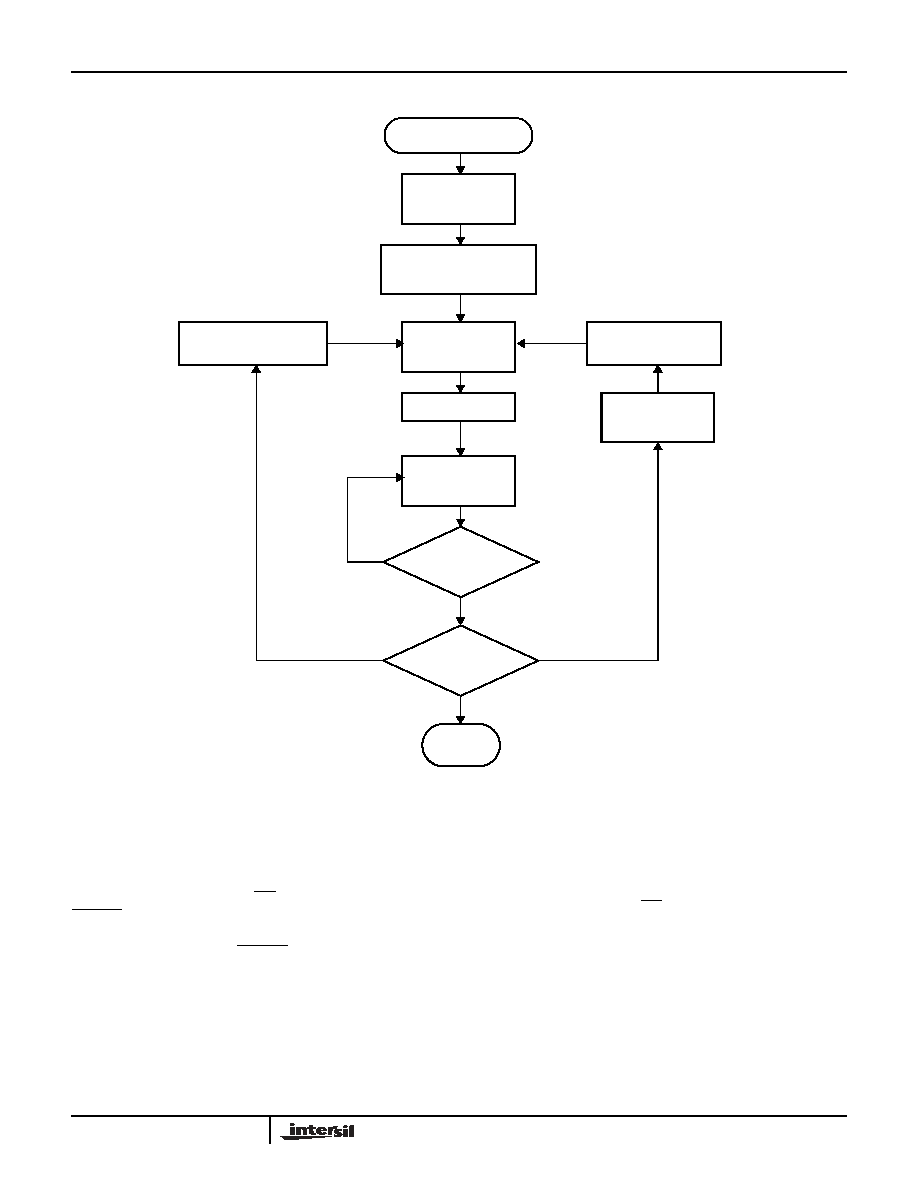
5
FN8125.0
April 6, 2005
Figure 4. V
TRIP
Programming Sequence
SPI INTERFACE
The device is designed to interface directly with the
synchronous Serial Peripheral Interface (SPI) of many
popular microcontroller families.
The device monitors the CS/WDI line and asserts
RESET output if there is no activity within user select-
able time out period. The device also monitors the V
CC
supply and asserts the RESET if V
CC
falls below a
preset minimum (V
TRIP
). The device contains an 8-bit
watchdog timer register to control the watchdog time
out period. The current settings are accessed via the
SI and SO pins.
All instructions (Table 1) and data are transferred MSB
first. Data input on the SI line is latched on the first ris-
ing edge of SCK after CS goes LOW. Data is output
on the SO line by the falling edge of SCK. SCK is
static, allowing the user to stop the clock and then start
it again to resume operations where left off.
V
TRIP
Programming
Apply 5V to V
CC
Decrement V
CC
RESET pin
goes active?
Measured V
TRIP
-
Desired V
TRIP
DONE
Execute
Sequence
Reset V
TRIP
Set V
CC
= V
CC
Applied =
Desired V
TRIP
Execute
Sequence
Set V
TRIP
New V
CC
Applied =
Old V
CC
Applied + Error
(V
CC
= V
CC
- 50mV)
Execute
Sequence
Reset V
TRIP
New V
CC
Applied =
Old V
CC
Applied - Error
Error < 0
Error = 0
YES
NO
Error > 0
X5001
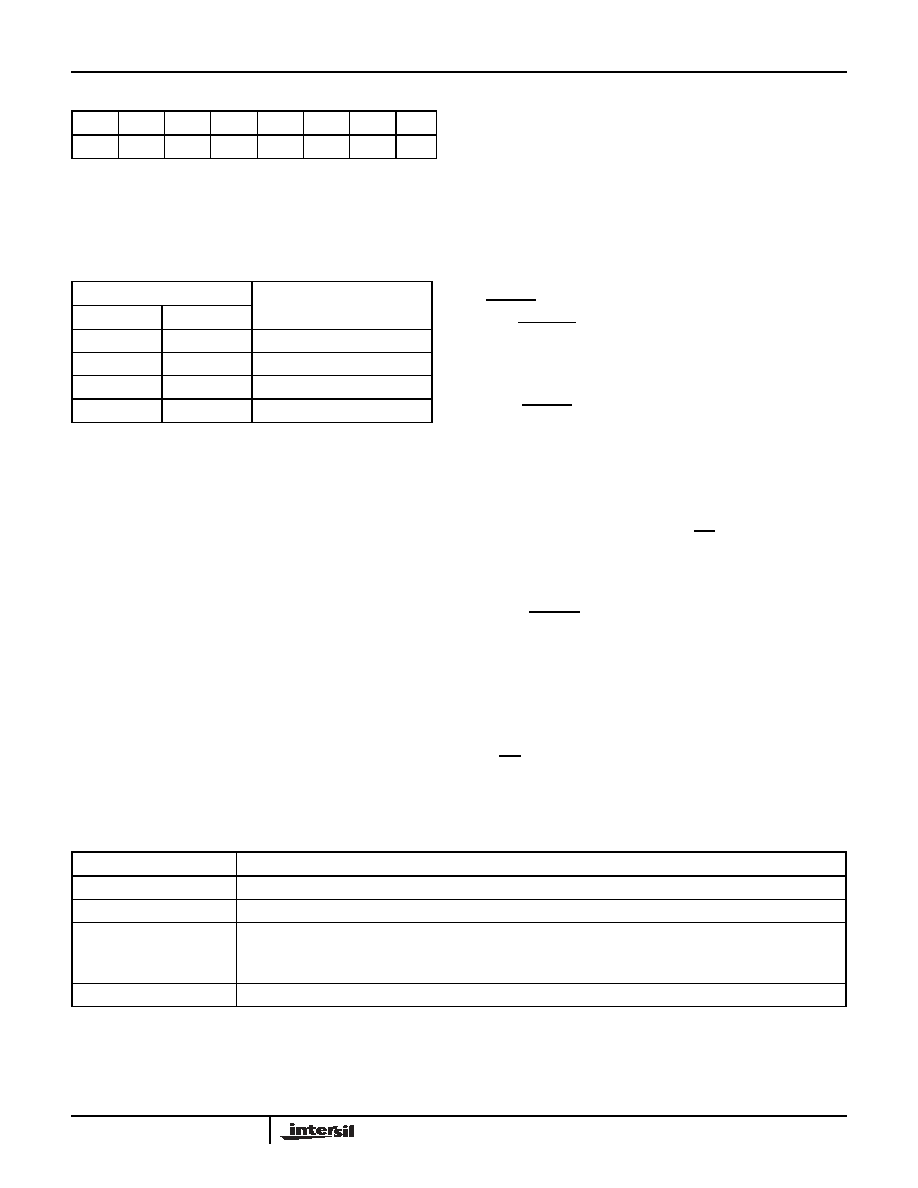
6
FN8125.0
April 6, 2005
Watchdog Timer Register
Watchdog Timer Control Bits
The watchdog timer control bits, WD
0
and WD
1
,
select the watchdog time out period. These nonvola-
tile bits are programmed with the set watchdog timer
(SWDT) instruction.
Write Watchdog Register Operation
Changing the watchdog timer register is a two step
process. First, the change must be enabled with by
setting the watchdog change latch (see below). This
instruction is followed by the set watchdog timer
(SWDT) instruction, which includes the data to be writ-
ten (Figure 5). Data bits 3 and 4 contain the watchdog
settings and data bits 0, 1, 2, 5, 6 and 7 must be "0".
Watchdog Change Latch
The watchdog change latch must be SET before a
Write watchdog timer operation is initiated. The
Enable Watchdog Change (EWDC) instruction will set
the latch and the Disable Watchdog Change (DWDC)
instruction will reset the latch (See Figure 6) This latch
is automatically reset upon a power-up condition and
after the completion of a valid nonvolatile write cycle.
Read Watchdog Timer Register Operation
If there is not a nonvolatile write in progress, the read
watchdog timer instruction returns the setting of the
watchdog timer control bits. The other bits are
reserved and will return'0' when read. See Figure 3.
If a nonvolatile write is in progress, the read watchdog
timer register Instruction returns a HIGH on SO. When
the nonvolatile write cycle is completed, a separate read
watchdog timer instruction should be used to determine
the current status of the watchdog control bits.
RESET Operation
The RESET (X5001) output is designed to go LOW
whenever V
CC
has dropped below the minimum trip
point and/or the watchdog timer has reached its pro-
grammable time out limit.
The RESET output is an open drain output and
requires a pull up resistor.
Operational Notes
The device powers-up in the following state:
≠ The device is in the low power standby state.
≠ A HIGH to LOW transition on CS is required to enter
an active state and receive an instruction.
≠ SO pin is high impedance.
≠ The watchdog change latch is reset.
≠ The RESET signal is active for t
PURST
.
Data Protection
The following circuitry has been included to prevent
inadvertent writes:
≠ A EWDC instruction must be issued to enable a
change to the watchdog timeout setting.
≠ CS must come HIGH at the proper clock count in
order to implement the requested changes to the
watchdog timeout setting.
Table 1. Instruction Set Definition
Note:
Instructions are shown with MSB in leftmost position. Instructions are transferred MSB first.
7
6
5
4
3
2
1
0
0
0
0
WD
1
WD
0
0
0
0
Watchdog Control Bits
Watchdog Time Out
(Typical)
WD1
WD0
0
0
1.4 seconds
0
1
600 milliseconds
1
0
200 milliseconds
1
1
disabled
Instruction Format
Instruction Name and Operation
0000 0110
EWDC: Enable Watchdog Change Operation
0000 0100
DWDC: Disable Watchdog Change Operation
0000 0001
SWDT: Set Watchdog Timer control bits:
Instruction followed by contents of register: 000(WD
1
) (WD
0
)000
See Watchdog Timer Settings and Figure 7
0000 0101
RWDT: Read Watchdog Timer control bits
X5001
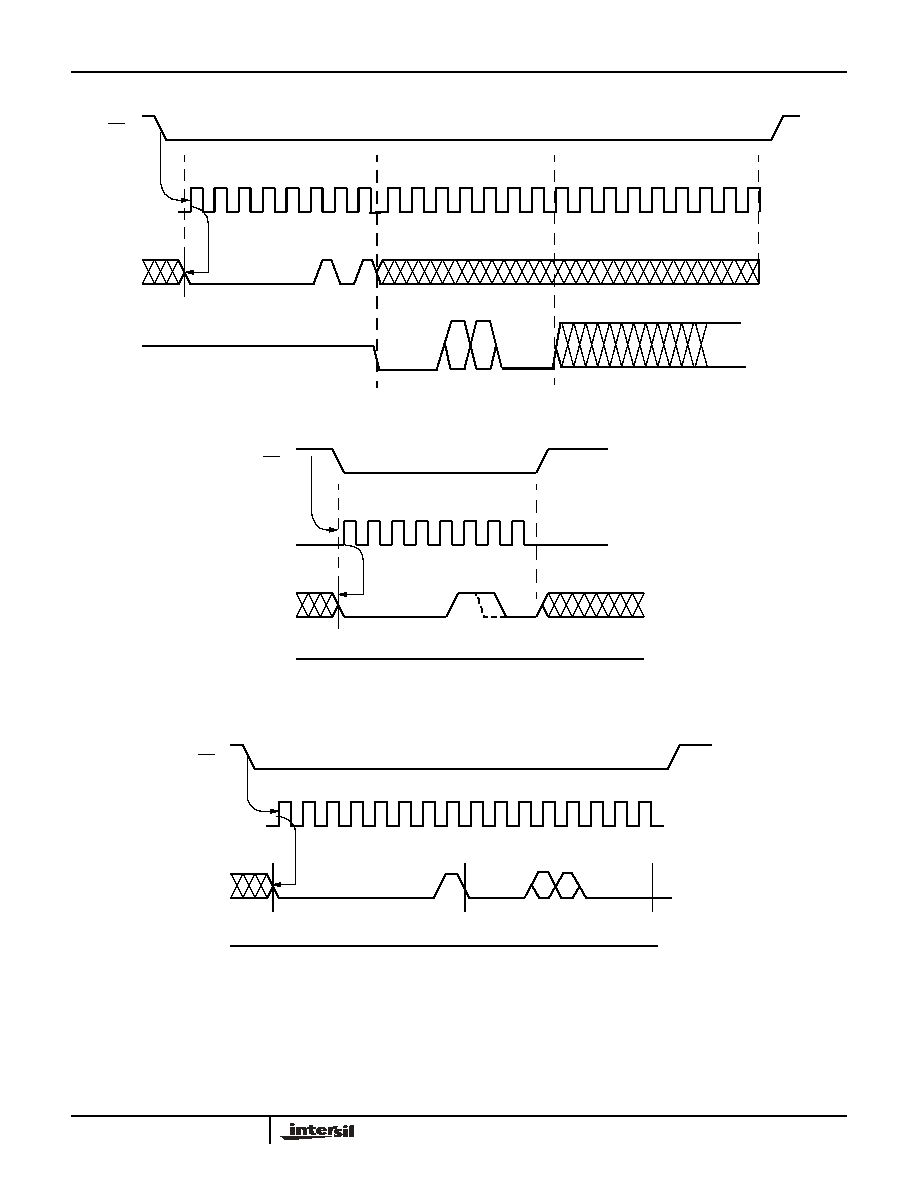
7
FN8125.0
April 6, 2005
Figure 5. Read Watchdog Timer Setting
Figure 6. Enable Watchdog Change/Disable Watchdog Change Sequence
Figure 7. Write Watchdog Timer Sequence
0
1
2
3
4
5
6
7
CS
SCK
SI
SO
RWDT
Instruction
...
...
...
W
D
0
W
D
1
0
1
2
3
4
5
6
7
CS
SI
SCK
High Impedance
SO
Instruction
(1 Byte)
0
1
2
3
4
5
6
7
8
9
CS
SCK
SI
SO
High Impedance
Instruction
10 11 12 13 14 15
Data Byte
6
5
4
3
W
D
1
W
D
0
X5001
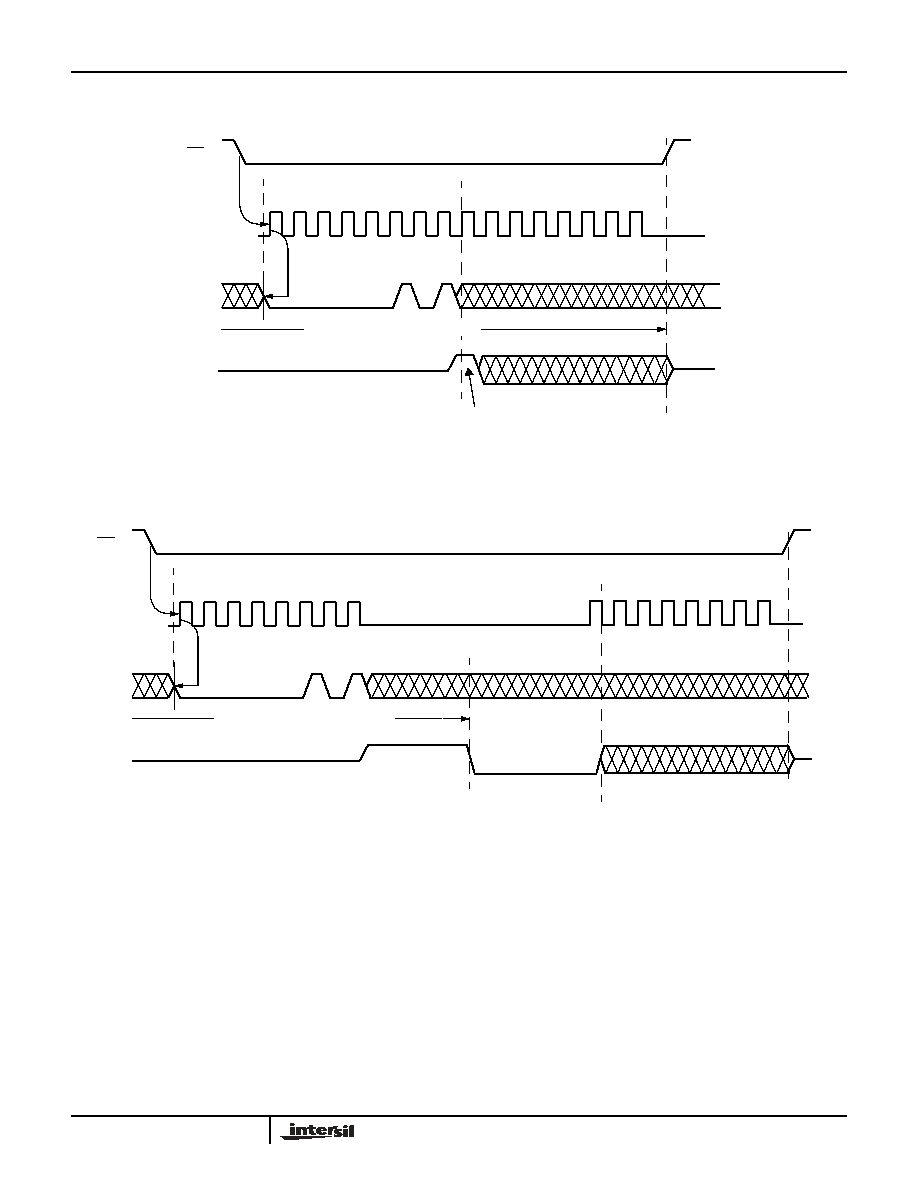
8
FN8125.0
April 6, 2005
Figure 8. Read Nonvolatile Status (Option 1) (Used to determine end of Watchdog Timer store operation)
Figure 9. Read Nonvolatile Status (Option 2) (Used to determine end of Watchdog Timer store operation)
0
1
2
3
4
5
6
7
CS
SCK
SI
SO
RWDT
Instruction
SO HIGH During 1st Bit While
in the Nonvolatile Write Cycle
Nonvolatile Write in Progress
0
1
2
3
4
5
6
7
CS
SCK
SI
SO
RWDT
Instruction
SO HIGH During
Nonvolatile Write Cycle
Nonvolatile Write in Progress
X5001
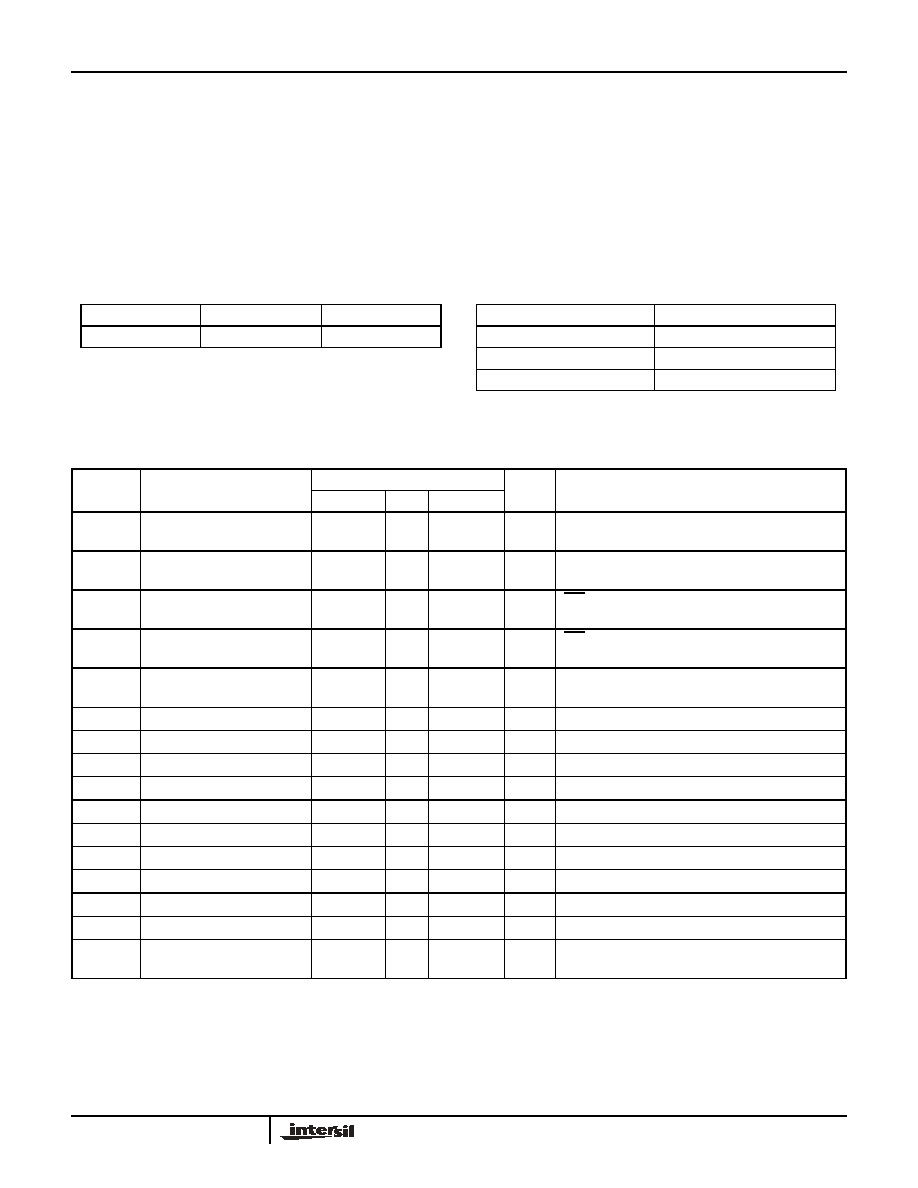
9
FN8125.0
April 6, 2005
ABSOLUTE MAXIMUM RATINGS
Temperature under bias ................... -65∞C to +135∞C
Storage temperature ........................ -65∞C to +150∞C
Voltage on any pin with
respect to V
SS
...................................... -1.0V to +7V
D.C. output current ............................................... 5mA
Lead temperature (soldering, 10 seconds)........ 300∞C
COMMENT
Stresses above those listed under "Absolute Maximum
Ratings" may cause permanent damage to the device.
This is a stress rating only; the functional operation of
the device (at these or any other conditions above
those listed in the operational sections of this specifi-
cation) is not implied. Exposure to absolute maximum
rating conditions for extended periods may affect
device reliability.
D.C. OPERATING CHARACTERISTICS (Over the recommended operating conditions unless otherwise specified.)
Symbol
Parameter
Limits
Unit
Test Conditions
Min.
Typ
Max.
I
CC1
V
CC
write current
(Active)
5
mA
SCK = V
CC
x 0.1/V
CC
x 0.9 @ 5MHz,
SO = Open
I
CC2
V
CC
read current
(Active)
0.4
mA
SCK = V
CC
x 0.1/V
CC
x 0.9 @ 5MHz,
SO = Open
I
SB1
V
CC
standby current
WDT=OFF
1
µA
CS = V
CC
, V
IN
= V
SS
or V
CC
, V
CC
= 5.5V
I
SB2
V
CC
standby current
WDT=ON
50
µA
CS = V
CC
, V
IN
= V
SS
or V
CC
, V
CC
= 5.5V
I
SB3
V
CC
standby current
WDT=ON
20
µA
CS = V
CC
, V
IN
= V
SS
or V
CC
, V
CC
= 3.6V
I
LI
Input leakage current
0.1
10
µA
V
IN
= V
SS
to V
CC
I
LO
Output leakage current
0.1
10
µA
V
OUT
= V
SS
to V
CC
V
IL
(1)
Input LOW voltage
-0.5
V
CC
x 0.3
V
V
IH
(1)
Input HIGH voltage
V
CC
x 0.7
V
CC
+ 0.5
V
V
OL1
Output LOW voltage
0.4
V
V
CC
> 3.3V, I
OL
= 2.1mA
V
OL2
Output LOW voltage
0.4
V
2V < V
CC
< 3.3V, I
OL
= 1mA
V
OL3
Output LOW voltage
0.4
V
V
CC
2V, I
OL
= 0.5mA
V
OH1
Output HIGH voltage
V
CC
-0.8
V
V
CC
> 3.3V, I
OH
= -1.0mA
V
OH2
Output HIGH voltage
V
CC
-0.4
V
2V < V
CC
3.3V, I
OH
= -0.4mA
V
OH3
Output HIGH voltage
V
CC
-0.2
V
V
CC
2V, I
OH
= -0.25mA
V
OLRS
Reset output LOW
voltage
0.4
V
I
OL
= 1mA
RECOMMENDED OPERATING CONDITIONS
Note:
PT= Package, Temperature
Temperature
Min.
Max.
Commercial
0∞C
+70∞C
Voltage Option
Supply Voltage Limits
-1.8
1.8V to 3.6V
-2.7 or -2.7A
2.7V to 5.5V
-4.5 or -4.5A
4.5V to 5.5V
X5001
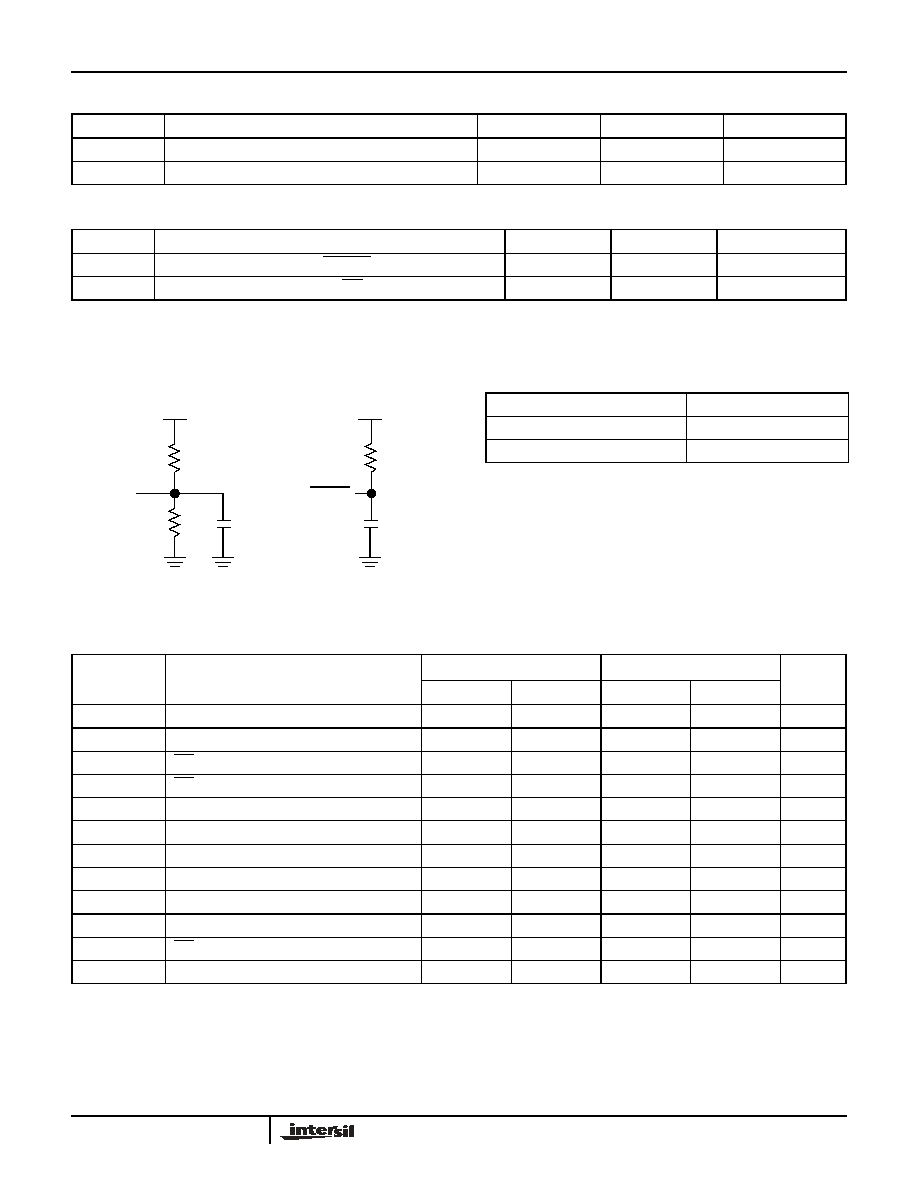
10
FN8125.0
April 6, 2005
POWER-UP TIMING
CAPACITANCE T
A
= +25∞C, f = 1MHz, V
CC
= 5V.
Notes: (1) V
IL
min. and V
IH
max. are for reference only and are not tested.
(2) This parameter is periodically sampled and not 100% tested.
EQUIVALENT A.C. LOAD CIRCUIT
A.C. TEST CONDITIONS
A.C. CHARACTERISTICS (Over recommended operating conditions, unless otherwise specified)
Data Input Timing
Symbol
Parameter
Min.
Max.
Unit
t
PUR
(2)
Power-up to read operation
1
ms
t
PUW
(2)
Power-up to write operation
5
ms
Symbol
Test
Max.
Unit
Conditions
C
OUT
(2)
Output capacitance (SO, RESET)
8
pF
V
OUT
= 0V
C
IN
(2)
Input capacitance (SCK, SI, CS)
6
pF
V
IN
= 0V
3V
Output
100pF
5V
3.3k
RESET
30pF
1.64k
1.64k
Input pulse levels
V
CC
x 0.1 to V
CC
x 0.9
Input rise and fall times
10ns
Input and output timing level
V
CC
x0.5
SymboL
Parameter
1.8V-3.6V
2.7V-5.5V
Unit
Min. Max.
Min. Max.
f
SCK
Clock frequency
0
1
0
2
MHz
t
CYC
Cycle time
1000
500
ns
t
LEAD
CS lead time
400
200
ns
t
LAG
CS lag time
400
200
ns
t
WH
Clock HIGH time
400
200
ns
t
WL
Clock LOW time
400
200
ns
t
SU
Data setup time
100
50
ns
t
H
Data hold time
100
50
ns
t
RI
(3)
Input rise time
2
2
µs
t
FI
(3)
Input fall time
2
2
µs
t
CS
CS deselect time
250
150
ns
t
WC
(4)
Write cycle time
10
10
ms
X5001

11
FN8125.0
April 6, 2005
Data Output Timing
Notes: (3) This parameter is periodically sampled and not 100% tested.
(4) t
WC
is the time from the rising edge of CS after a valid write sequence has been sent to the end of the self-timed internal nonvolatile
write cycle.
Figure 10. Data Output Timing
Figure 11. Data Input Timing
Symbol Parameter
1.8V-3.6V
2.7V-5.5V
Unit
Min.
Max.
Min.
Max.
f
SCK
Clock frequency
0
1
0
2
MHz
t
DIS
Output disable time
400
200
ns
t
V
Output valid from clock low
400
200
ns
t
HO
Output hold time
0
0
ns
t
RO
(3)
Output rise time
300
150
ns
t
FO
(3)
Output fall time
300
150
ns
SCK
CS
SO
SI
MSB Out
MSB≠1 Out
LSB Out
ADDR
LSB IN
t
CYC
t
V
t
HO
t
WL
t
WH
t
DIS
t
LAG
SCK
CS
SI
SO
MSB In
t
SU
t
RI
t
LAG
t
LEAD
t
H
LSB In
t
CS
t
FI
High Impedance
X5001

12
FN8125.0
April 6, 2005
SYMBOL TABLE
Figure 12. Power-Up and Power-Down Timing
RESET Output Timing
Note:
(5) This parameter is periodically sampled and not 100% tested.
PT = Package, Temperature
WAVEFORM
INPUTS
OUTPUTS
Must be
steady
Will be
steady
May change
from LOW
to HIGH
Will change
from LOW
to HIGH
May change
from HIGH
to LOW
Will change
from HIGH
to LOW
Don't Care:
Changes
Allowed
Changing:
State Not
Known
N/A
Center Line
is High
Impedance
Symbol
Parameter
Min.
Typ.
Max.
Unit
V
TRIP
Reset trip point voltage, X5001PT-4.5A
Reset trip point voltage, X5001PT-4.5
Reset trip point voltage, X5001PT-2.7A
Reset trip point voltage, X5001PT-2.7
Reset trip point voltage, X5001PT-1.8
4.50
4.25
2.85
2.55
1.70
4.63
4.38
2.92
2.63
1.75
4.75
4.50
3.00
2.70
1.80
V
t
PURST
Power-up reset timeout
100
200
280
ms
t
RPD
(5)
V
CC
detect to reset/output
500
ns
t
F
(5)
V
CC
fall time
0.1
ns
t
R
(5)
V
CC
rise time
0.1
ns
V
RVALID
Reset valid V
CC
1
V
V
CC
t
PURST
t
PURST
t
R
t
F
t
RPD
RESET (X5001)
0 Volts
V
TRIP
V
TRIP
X5001
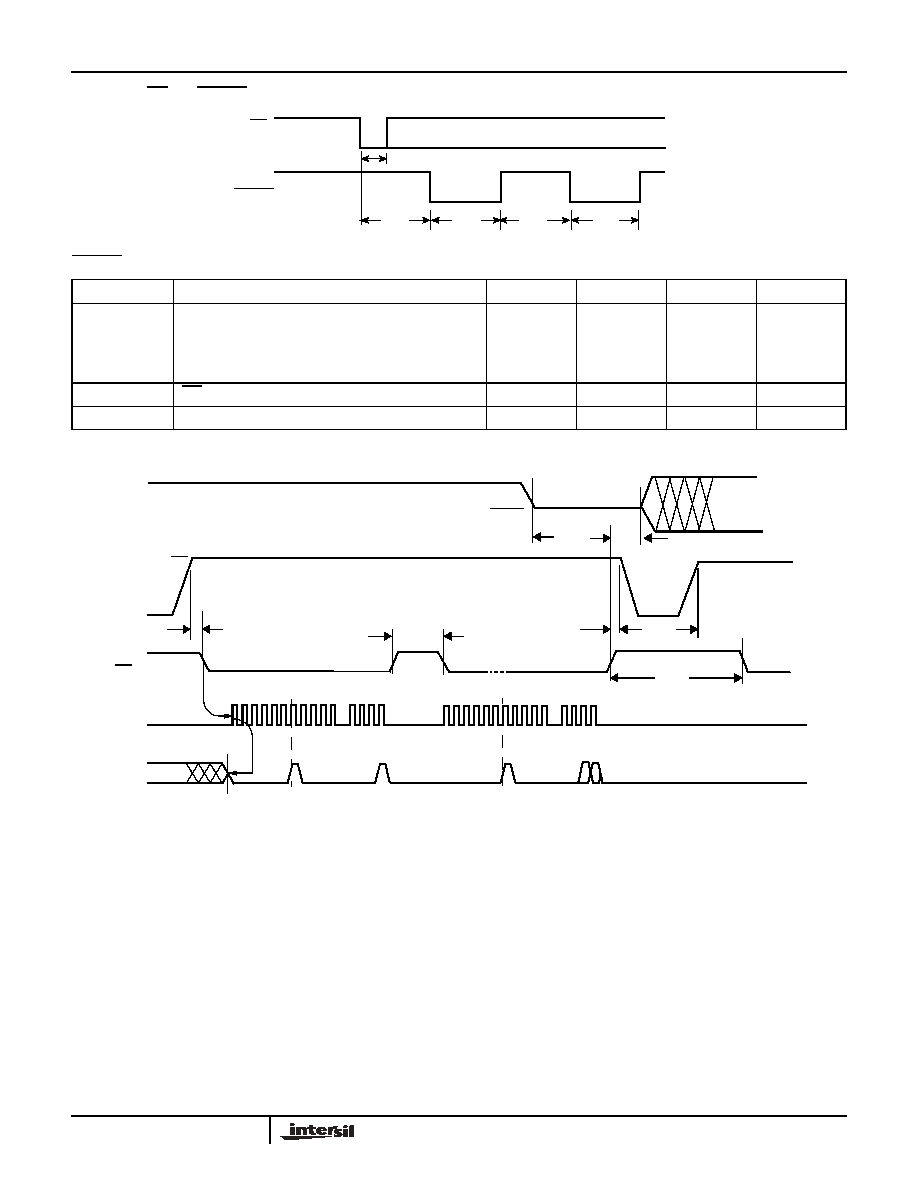
13
FN8125.0
April 6, 2005
Figure 13. CS vs. RESET Timing
RESET Output Timing
V
TRIP
Programming Timing Diagram
Symbol
Parameter
Min.
Typ.
Max.
Unit
t
WDO
Watchdog timeout period,
WD
1
= 1, WD
0
= 0
WD
1
= 0, WD
0
= 1
WD
1
= 0, WD
0
= 0
100
450
1
200
600
1.4
300
800
2
ms
ms
sec
t
CST
CS pulse width to reset the watchdog
400
ns
t
RST
Reset Timeout
100
200
300
ms
CS
t
CST
RESET
t
WDO
t
RST
t
WDO
t
RST
SCK
SI
CS
0001h or
02h
V
CC
(V
TRIP
)
V
PE
t
TSU
t
THD
t
VPH
t
VPS
V
P
V
TRIP
t
RP
t
VPO
t
PCS
0003h
0001h
03h
X5001

14
FN8125.0
April 6, 2005
V
TRIP
Programming Parameters
Parameter
Description
Min.
Max.
Unit
t
VPS
V
TRIP
program enable voltage setup time
1
µs
t
VPH
V
TRIP
program enable voltage hold time
1
µs
t
PCS
V
TRIP
programming CS inactive time
1
µs
t
TSU
V
TRIP
setup time
1
µs
t
THD
V
TRIP
hold (stable) time
10
ms
t
WC
V
TRIP
write cycle time
10
ms
t
VPO
V
TRIP
program enable voltage Off time (between successive adjustments)
0
µs
t
RP
V
TRIP
program recovery period (between successive adjustments)
10
ms
V
P
Programming voltage
15
18
V
V
TRAN
V
TRIP
programmed voltage range
1.7
5.0
V
V
ta1
Initial V
TRIP
program voltage accuracy (V
CC
applied-V
TRIP
) (programmed at 25∞C)
-0.1
+0.4
V
V
ta2
Subsequent V
TRIP
program voltage accuracy [(V
CC
applied-V
ta1
)-V
TRIP
.
Programmed at 25∞C.]
-25
+25
mV
V
tr
V
TRIP
program voltage repeatability (Successive program operations. Programmed at
25∞C.)
-25
+25
mV
V
tv
V
TRIP
program variation after programming (0-75∞C). (programmed at 25∞C)
-25
+25
mV
V
TRIP programming parameters are periodically sampled and are not 100% tested.
X5001

15
FN8125.0
April 6, 2005
Watchdog Timer On (V
CC
= 5V)
Watchdog Timer On (V
CC
= 3V)
Watchdog Timer Off (V
CC
= 3V, 5V)
-40C
25C
90C
Temp (c)
Isb (µA)
V
CC
Supply Current vs. Temperature (I
SB
)
t
WDO
vs. Voltage/Temperature (WD1, 0 = 1, 1)
V
TRIP
vs. Temperature (programmed at 25∞C)
t
WDO
vs. Voltage/Temperature (WD1, 0 = 1, 0)
t
PURST
vs. Temperature
t
WDO
vs. Voltage/Temperature (WD1, 0 0 = 0, 1)
1.85
1.80
1.75
1.70
1.65
1.60
1.55
1.50
1.45
1.40
1.7
3.1
4.5
90∞C
25∞C
-40∞C
Re
set (s
econ
d
s)
Voltage
5.025
5.000
4.975
3.525
3.500
3.475
2.525
2.500
2.475
0
25
85
Volta
g
e
Temperature
V
TRIP
= 5V
V
TRIP
= 3.5V
V
TRIP
= 2.5V
0.85
0.80
0.75
0.70
0.65
0.60
1.7
4.5
R
eset (
secon
d
s)
Voltage
3.1
90∞C
25∞C
-40∞C
275
270
265
260
255
250
245
240
235
-40
25
90
Degrees ∞C
280
Time
(ms
)
90∞C
25∞C
-40∞C
0.28
0.27
0.26
0.25
0.24
0.23
0.22
0.21
0.20
0.29
R
eset (
secon
d
s)
Voltage
1.7
3.1
4.5
14
11
17
15
20
18
0.35
0.55
1.0
0.30
X5001

16
FN8125.0
April 6, 2005
PACKAGING INFORMATION
0.150 (3.80)
0.158 (4.00)
0.228 (5.80)
0.244 (6.20)
0.014 (0.35)
0.019 (0.49)
Pin 1
Pin 1 Index
0.010 (0.25)
0.020 (0.50)
0.050 (1.27)
0.188 (4.78)
0.197 (5.00)
0.004 (0.19)
0.010 (0.25)
0.053 (1.35)
0.069 (1.75)
(4X) 7∞
0.016 (0.410)
0.037 (0.937)
0.0075 (0.19)
0.010 (0.25)
0∞ - 8∞
X 45∞
8-Lead Plastic Small Outline Gull Wing Package Type S
NOTE: ALL DIMENSIONS IN INCHES (IN PARENTHESES IN MILLIMETERS)
0.250"
0.050" Typical
0.050"
Typical
0.030"
Typical
8 Places
FOOTPRINT
X5001
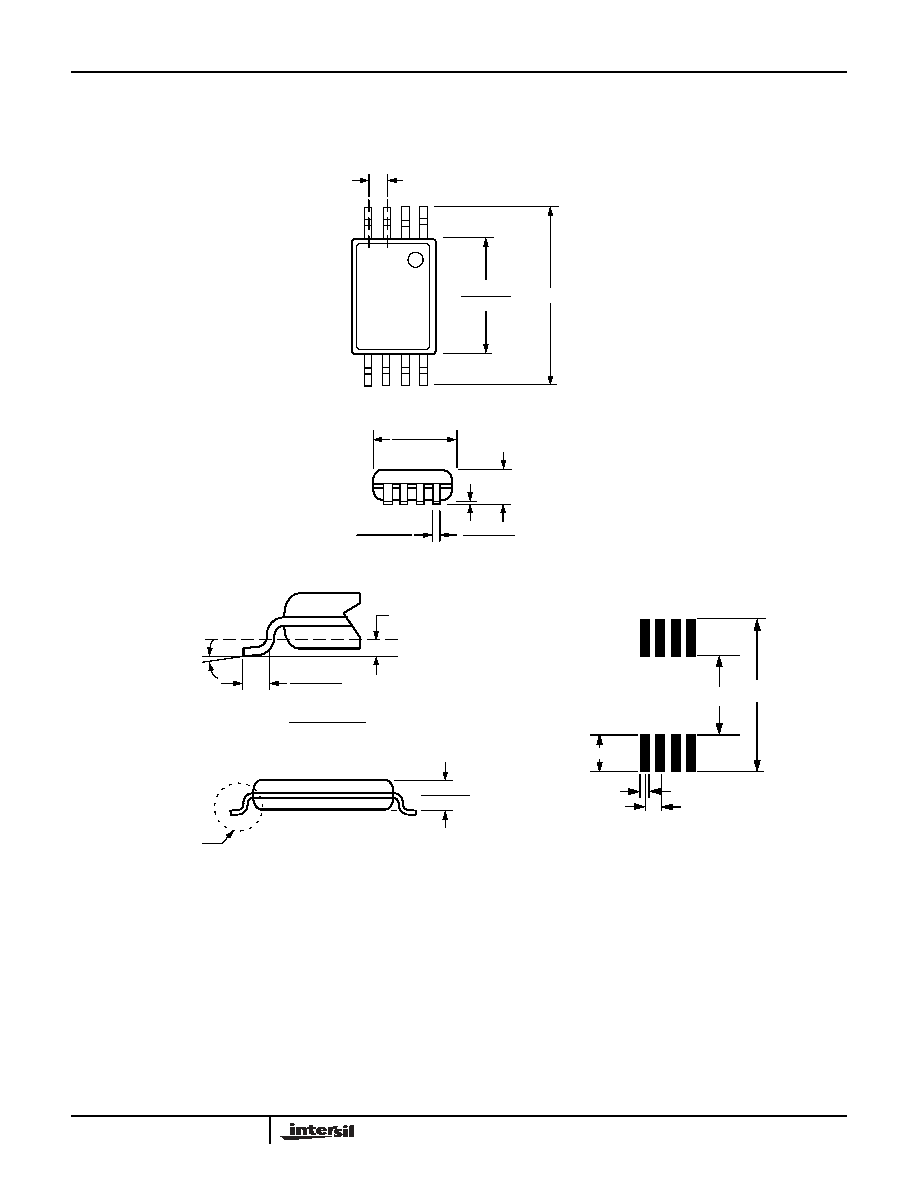
17
FN8125.0
April 6, 2005
PACKAGING INFORMATION
NOTE: ALL DIMENSIONS IN INCHES (IN PARENTHESES IN MILLIMETERS)
8-Lead Plastic, TSSOP, Package Type V
See Detail "A"
.031 (.80)
.041 (1.05)
.169 (4.3)
.177 (4.5)
.252 (6.4) BSC
.025 (.65) BSC
.114 (2.9)
.122 (3.1)
.002 (.05)
.006 (.15)
.047 (1.20)
.0075 (.19)
.0118 (.30)
0∞ - 8∞
.010 (.25)
.019 (.50)
.029 (.75)
Gage Plane
Seating Plane
Detail A (20X)
(4.16) (7.72)
(1.78)
(0.42)
(0.65)
All Measurements Are Typical
X5001

18
All Intersil U.S. products are manufactured, assembled and tested utilizing ISO9000 quality systems.
Intersil Corporation's quality certifications can be viewed at www.intersil.com/design/quality
Intersil products are sold by description only. Intersil Corporation reserves the right to make changes in circuit design, software and/or specifications at any time without
notice. Accordingly, the reader is cautioned to verify that data sheets are current before placing orders. Information furnished by Intersil is believed to be accurate and
reliable. However, no responsibility is assumed by Intersil or its subsidiaries for its use; nor for any infringements of patents or other rights of third parties which may result
from its use. No license is granted by implication or otherwise under any patent or patent rights of Intersil or its subsidiaries.
For information regarding Intersil Corporation and its products, see www.intersil.com
FN8125.0
April 6, 2005
Ordering Information
Part Mark Information
V
CC
Range
V
TRIP
Range
Package
Operating Temperature Range
Part Number RESET
(Active LOW)
4.5-5.5V
4.5.4.75
8-Pin PDIP
0-70∞C
X5001P-4.5A
8-Lead SOIC
0-70∞C
X5001S8-4.5A
8-Lead TSSOP
0-70∞C
X5001V8-4.5A
4.5-5.5V
4.25.4.5
8-Pin PDIP
0-70∞C
X5001P
8-Lead SOIC
0-70∞C
X5001S8
8-Lead TSSOP
0-70∞C
X5001V8
2.7-5.5V
2.85-3.0
8-Lead SOIC
0-70∞C
X5001S8-2.7A
2.7-5.5V
2.55-2.7
8-Lead SOIC
0-70∞C
X5001S8-2.7
8-Lead TSSOP
0-70∞C
X5001V8-2.7
8-Lead TSSOP
501AG = 1.8 to 3.6V, 0 to +70∞C, V
TRIP
= 1.7-1.8V
YWW
XXXXX
501AH = 1.8 to 3.6V, -40 to +85∞C, V
TRIP
= 1.7-1.8V
501F = 2.7 to 5.5V, 0 to +70∞C, V
TRIP
= 2.55-2.7V
501G = 2.7 to 5.5V, -40 to +85∞C, V
TRIP
= 2.55-2.7V
X501 = 4.5 to 5.5V, 0 to +70∞C, V
TRIP
= 4.25-4.5V
501I = 4.5 to 5.5V, -40 to +85∞C, V
TRIP
= 4.25-4.5V
8-Lead SOIC
X5001
YWW XX
AG = 1.8 to 3.6V, 0 to +70∞C, V
TRIP
= 1.7-1.8V
AH = 1.8 to 3.6V, -40 to +85∞C, V
TRIP
= 1.7-1.8V
F = 2.7 to 5.5V, 0 to +70∞C, V
TRIP
= 2.55-2.7V
G = 2.7 to 5.5V, -40 to +85∞C, V
TRIP
= 2.55-2.7V
I = 4.5 to 5.5V, -40 to +85∞C, V
TRIP
= 4.25-4.5V
501AN = 2.7 to 5.5V, 0 to +70∞C, V
TRIP
= 2.85-3.0V
501AP = 2.7 to 5.5V, -40 to +85∞C, V
TRIP
= 2.85-3.0V
501AL = 4.5 to 5.5V, 0 to +70∞C, V
TRIP
= 4.5-4.75V
501AM = 4.5 to 5.5V, -40 to +85∞C, V
TRIP
= 4.5-4.75V
AN = 2.7 to 5.5V, 0 to +70∞C, V
TRIP
= 2.85-3.0V
AP = 2.7 to 5.5V, -40 to +85∞C, V
TRIP
= 2.85-3.0V
AL = 4.5 to 5.5V, 0 to +70∞C, V
TRIP
= 4.5-4.75V
AM = 4.5 to 5.5V, -40 to +85∞C, V
TRIP
= 4.5-4.75V
Blank = 4.5 to 5.5V, 0 to +70∞C, V
TRIP
= 4.25-4.5V
YWW = year/work week device is packaged.
X5001

















